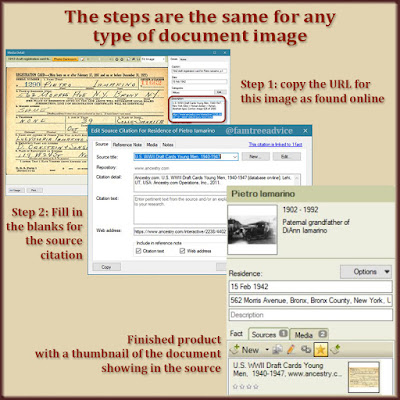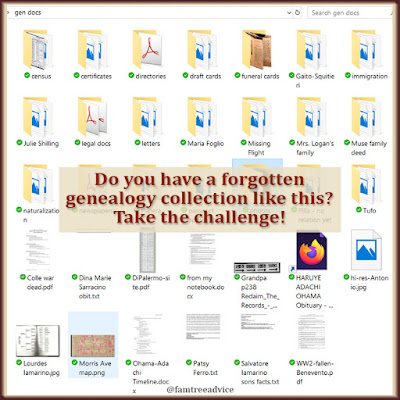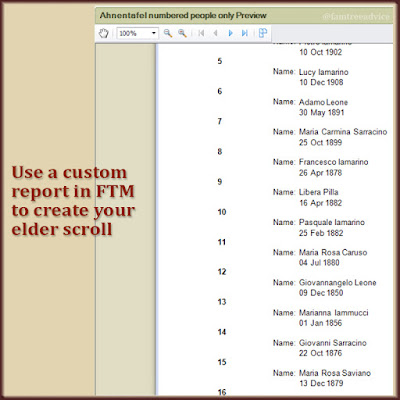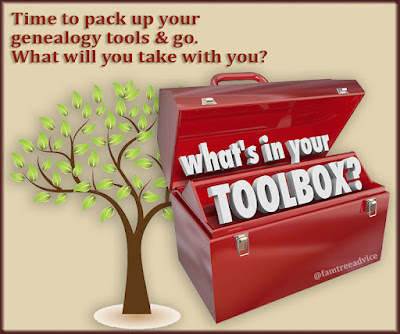Work smarter by combining your genealogy projects wherever you can.
Have I overloaded you with family tree cleanup projects? I know I can't keep up. Let's take a look at some of these projects with 2 goals in mind:
- Choose which projects you really want to get done, and
- See how you can combine 2 or more tasks and work smarter.
1. Create a Direct Ancestor List with Ahnentafel Numbers
See "Overwhelming Clean-up Task? Start With Direct Ancestors." Add a custom fact field to hold each direct ancestor's Ahnentafel number. If you can, give each of your 4 branches an identifier. In Family Tree Maker you can color-code a person and all their ancestors. I've given a different color to each of my 4 grandparents and their direct ancestors.
Now I can instantly spot the more than 290 direct ancestors in my tree. This was a one-day project. The color-coding took a minute. Finding and adding each ancestor's Ahnentafel number took an hour or two.
Check your Grandparent Chart for the Ahnentafel number. Don't have one? That's another project you can do in a day.
Whenever you have an overwhelming project to do, take care of your direct ancestors first. That's a lot less to bite off and a great start.
2. Create Your Elder Scroll
Here's a natural project combination point. See "Make Your Own 'Elder Scrolls'." That custom Ahnentafel field from project #1 makes it easy (in some software) to create a custom report. List your direct ancestors (starting with you) in Ahnentafel order. Include each person's name and birth date. Print it out and tape the sheets together, end-to-end. That's your Elder Scroll.
If you've done project #1, you can do project #2 quickly. This is a fun project with a result you can hold in your hands.
3. Get Your "Shoebox" Items into Your Tree
See "How Many Genealogy Gems Are You Sitting On?" Sometimes I see a photo of a relative on Facebook or in a cousin's online family tree. I save the image and keep it in my "gen docs" folder and in the "photos" sub-folder. Apparently I've been doing this with all kinds of family tree documents for years.
 |
| When working on a project to add photos to my tree, I realized I had to find the man's whole family. |
This weekend I gave my virtual shoebox some attention. I started with census sheet images for people who I thought should be my relatives. Years later, I've built my family tree out so much that voila! Those people are in my tree now! I'm winnowing down my gen docs folder, but it's big.
4. Process All Facts and Documents for a Person at Once
Here's another project combination point. See "Make Smarter Progress on Your Family Tree." I was working on photos in my virtual shoebox, trying to place them in my family tree. When I got to one family portrait, I realized I hadn't documented the family of the father in the portrait.
So while I was there adding his photo, I went after his birth record and added his parents. His father fit into another family unit that was in my tree already. His mother needed more work.
I found her 1850 birth record. Then I found her parents' marriage records. I added each new vital record to my tree with source citations for each fact.
5. Write Your Ancestors' Life Stories
See "Which of Your Ancestors Has the Best Life Story?" When you're working on nearly any of the other projects, you can combine it with this one. Let's say you realize you have a ton of documents and facts for one of your ancestors. There aren't many holes left to fill.
This would be a great time to pull together the timeline of that ancestor's life story. You family tree software can help you by displaying that timeline. How would you tell this person's story? What family anecdotes can you add to bring this ancestor to life?
It can help to break the task into chunks. Capture their timeline of events in a Word document. Later add a couple of photos. Then add in some family stories.
6. Fully Document Your Ancestor's Entire Community
I don't know which other countries make this so easy. But if you have Italian family, you may be able to download your ancestral hometown's records. I did. See "3 Steps to My Ultimate, Priceless Family Tree."
I'm approaching this collection in a few ways, making progress on each of them:
- Rename each file to include the name of the subject. Then the whole collection becomes searchable on my computer.
- Add each document's main facts to a spreadsheet. This helps with searches and will be shareable with other descendants of the towns.
- Go through that spreadsheet line-by-line to see who can fit into my tree. Then get them in there.
My renamed files make it so easy to locate a record and build out a family. In project #4 above, I realized I didn't have any documentation on the ancestors of the man in the family portrait. So I searched my computer for his name, found his birth record, and kept going up and up his family tree.
This project benefits everything else I do.
7. Choose a Ripe DNA Match and Pursue the Connection
By "ripe" I mean a DNA match with a decent family tree. See "Can't Connect to Your DNA Match? Keep Trying."
I like to revisit my unsolved, ripe DNA matches once in a while. There's a chance that my other projects wound up adding a connection to a DNA match.
I'm trying to keep all my projects moving.
Decide which projects matter to you. Start doing any one of them with the others always in mind. Don't be afraid to go off on a tangent if it means you'll make progress on another project.
Keep track of where you left off on any one project, take care of that tangent, and come back to where you left off. Keep making valuable progress on your family tree—your legacy.
And happy birthday to George Harrison! He isn't gone. Shut up.





















